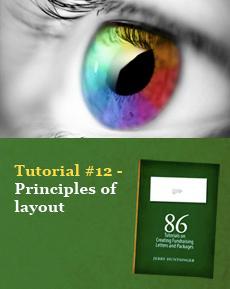Tutorial 12: Principles of layout
There are four critical principles: space importance, eye movement, right dominance, and horizontal and vertical lines.
- Written by
- Jerry Huntsinger
- Added
- February 17, 2019
1) Space importance

The most important elements of the letter must be designed to be the most dominant. For example, if you bury the date below a letterhead, the letterhead becomes dominant. The date recedes because it is not given space importance.
If you have an important statement to make, yet bury the words in the body of a paragraph, you have violated ‘space importance’.
Don’t fall into the trap of thinking that just because you have stated a fact, you have communicated.
2) Eye movement
The following observations relate to English and any other language that is read from left to right.
Eye movement research shows that the human eye does not neatly begin at the top of the page and then move left to right in a rigid pattern.
Instead, the eye tends to jump around and rests on whatever seems the most inviting or exciting.
Most people begin a letter without a great deal of interest and the eye tends to wander, jumping here and there, with incredible speed.
But we do know one firm fact about eye movement and readership.
Memorise this: letters, ads, brochures and leaflets are scanned before they are read.
Here are a few basic principles of eye movement:
- The eye tends to move at incredible speed until something stops it.
- You must provide many ‘stoppers’ throughout the letter.
- Donor names almost always stop the eye.
- Pictures almost always stop the eye.
But when does the eye stop jumping around the letter? When the mind takes over and begins controlling the movement of the eye. At that precise moment, readership and retention begin. Your copy takes over, the reader begins moving through the story.
3) Right dominance
When the eye begins moving in a controlled pattern, the principle of right dominance takes over. The eye begins reading on the left and moves toward the right. Any distraction on the right side tends to block the movement of the eye and impedes the jump back toward the left side. But distraction on the left doesn’t seem to bother the eye.
Another way to express this phenomenon is that the eye becomes fixed on the left, but jumps at the end of the line on the right. A distraction on the right stops the jump.
What does all this mean for layout?
In brief, you can put all the clutter you want on the left – letterhead, board names, pictures, logo, you name it. But on the right, watch out. Keep the space clean and open.
Anything else blocks readability.
In mail order layout you have to relate this to the principle of controlled clutter. You can pack a surprising amount of copy and pictures into a layout, as long as the top right-hand corner is clean.
You may be wondering, what about a letter using a picture on the upper right-hand corner? This relates to the principle of ‘space importance’. If the picture is your major selling point, then the picture becomes more important than the copy. You give it ‘space importance’. You want the eye to become fixed on the picture.
4) Horizontal and vertical lines
If you use an artist to design any part of your direct mail package, discuss the principle of keeping everything straight up and down.
Anytime you begin designing circles or laying out material in a circle, you are probably in trouble. And when you begin using slanted lines, or a slanted design, you are in worse trouble.
I really don’t know why, but for some reason circles and slanted lines tend to distract the reader. And the letter starts to become something other than a letter. You can use a small circle in a logo or letterhead – but don’t use a series of circles throughout the letter design.
As you collect sample letters, please note how a letterhead strung out across the top of the sheet detracts from the headline, date and salutation. That’s the principle of ‘space importance’. No one has ever proved that a letterhead increases response to an appeal. Yet, when the letterhead dominates the letter, something is wrong with the priorities.
There’s more
Okay, you are ready to design your own letter. So take a plain sheet of paper, put the date at the top – it becomes dominant, obviously, because nothing else is on the sheet.
Then, put a headline under the date. The date is still dominant, isn’t it? Put a ruled line down the left-hand side of the paper, draw in some names and a letterhead. It doesn’t detract from the date or the headline, does it?
I think you see the principles involved. Take another sheet of paper and draw a line on the right side, and fill in the space. Then type on the paper. Note how the material on the right impedes your eye movement?
Try putting a letterhead or pictures at the bottom of the sheet. This way, it doesn’t interfere with vital ingredients. If you must use a letterhead at the top, try to position it in the far left and avoid going past the centre of the page.
As a general rule, a personalised letter will have a letterhead, simply because it gives the sheet a more formal, dressed-up look. But position the date well below the letterhead, or to the far right. Give the date ‘space importance’.
For a non-personalised letter, you should rarely use a letterhead, because you already have two strikes against you and you must resort to every selling technique at your disposal.
This means that almost anything is more important than the letterhead.
Many non-personalised letters use pictures effectively, but often pictures on a personalised letter have a negative value and detractfrom the personalisation.
Layout recommendations
- Make everything easy to read, use short paragraphs, indent the first line of every paragraph.
- Use underlining to catch the eye.
- Avoid all caps. CAPITAL LETTERS ARE DIFFICULT TO READ, AND GIVE THE FEELING THAT YOU ARE SHOUTING. But when you underline your words, the effect is stronger.
- Keep your lines short – don’t discourage the eye with long lines and skimpy white space. Wide margins increase readership.
- Use dashes instead of commas – at times – to break up the routine look.
- Be sure and put one eye grabber on each page.
- Use large typefaces. Only one per cent of the population has perfect eyesight.
Letters, ads, brochures and leaflets are scanned before they are read.
The reader may begin with the PS, with a picture, with a headline, with a quick look at the signature – or the reader may scan a dozen different parts of the letter, all in a series of marvelously swift eye movements.
Then, messages are transmitted to the brain: ‘Nothing here worth bothering with,’ and the letter is dead.
Or the message may be, ‘Hmm, what’s this all about?’
If you provide good visuals, the message to the brain says, ‘Let’s look at the picture a moment, and rest my weary eyes.’
Or, if the donor’s name is a dominant feature, the message says, ‘Hey, that’s my name.
Rather nice looking, isn’t it? Let’s take a closer look.’
© SOFII Foundation 2010-2014.

















